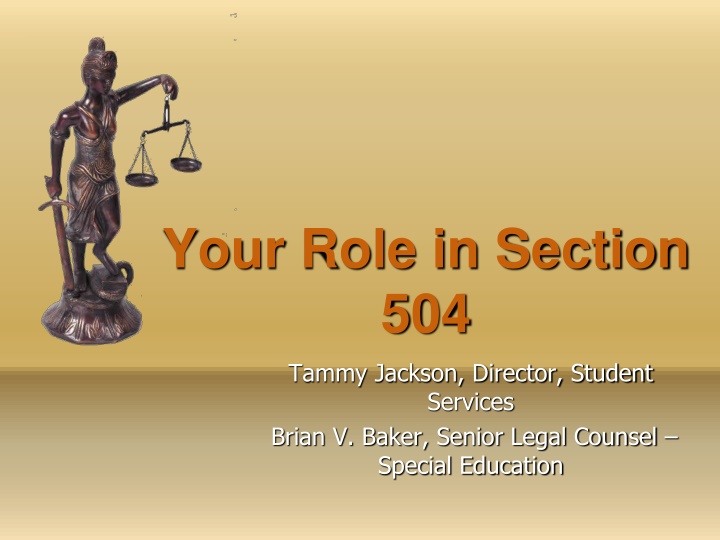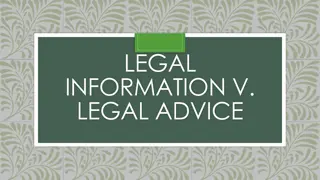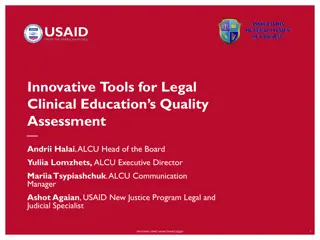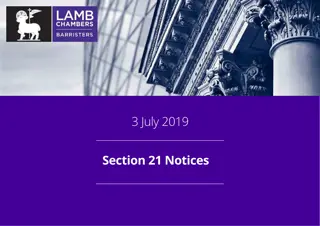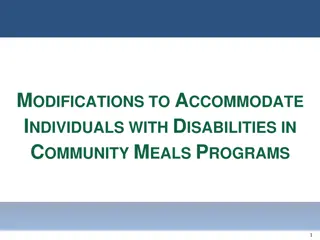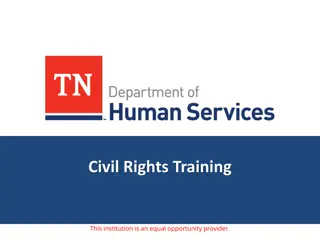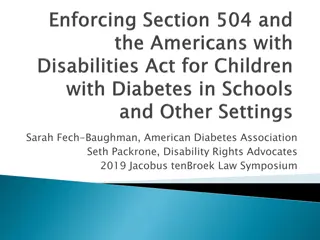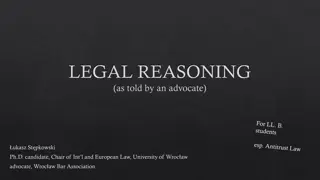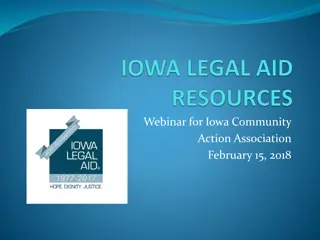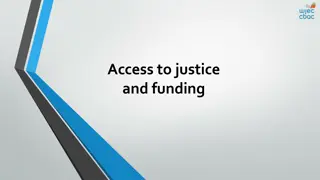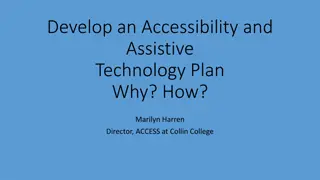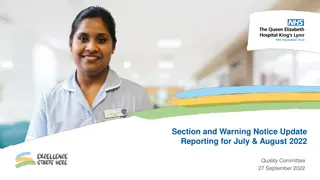Role in Section 504: Educational Needs & Legal Compliance
Identify process and procedure to meet educational needs of children with disability in PPS. Recognize educational risk factors for children with disability and understand state and federal education laws guiding our role in Section 504. Learn about crafting 504 plans, avoiding pitfalls, and ensuring access to appropriate supports, services, and accommodations.
Download Presentation

Please find below an Image/Link to download the presentation.
The content on the website is provided AS IS for your information and personal use only. It may not be sold, licensed, or shared on other websites without obtaining consent from the author.If you encounter any issues during the download, it is possible that the publisher has removed the file from their server.
You are allowed to download the files provided on this website for personal or commercial use, subject to the condition that they are used lawfully. All files are the property of their respective owners.
The content on the website is provided AS IS for your information and personal use only. It may not be sold, licensed, or shared on other websites without obtaining consent from the author.
E N D
Presentation Transcript
Your Role in Section 504 Tammy Jackson, Director, Student Services Brian V. Baker, Senior Legal Counsel Special Education
Learning Objectives Identify process and procedure to meet the educational needs of children with disability in PPS. Identify educational risk factors for children with disability. Recognize how state and federal education laws and policies direct our role.
Sec. 504: Our goal is to Understand how students are identified for special education and 504. Understand how to craft a 504 plan that includes the appropriate supports, services, and accommodations for an eligible student. Avoid common pitfalls leading to a denial of FAPE (free and appropriate public education)
Sec. 504 definitions Actual Impairment. History of Impairment. Perceived Impairment. Must substantially impact major life activities such as learning. OCR: significant focus since 2008 Amendments Act passage.
Sec. 504 physical or mental impairment Mental Physical Diabetes Seizure Disorder Severe food allergy Juvenile Rheumatoid Arthritis Spina Bifida Hearing impairment Gastro-intestinal (Chrone s, IBS) ADHD Obsessive-compulsive disorder Severe depression Learning disorder Anxiety disorder
Sec. 504/IDEA Students with a broad range of disabilities must have access to school facilities and programs, similar to non-disabled students. Many students who do not qualify for special education are covered by Section 504. Are you considering both Acts?
Sec. 504 Major Life Activities Not limited to specific list Not limited to learning doesn t have to be learning to be protected by 504 in schools Two types major life activities & major bodily functions
Major Life Activities (italics added by ADAA) Walking Standing Hearing Seeing Major Life Activities Learning Reading Concentrating Thinking Speaking Sleeping Bending Caring for one s self Lifting Performing manual tasks Major Bodily Functions Breathing/respiratory Digestive functioning Bowel/bladder Neurological/brain Endocrine
Sec 504 substantial limitation A physical or mental impairment substantially limits a major activity when a child is restricted as to condition, manner, or duration in performance of basic life activity compared to avg person in the general population. An impairment need not prevent or severely or significantly restrict a major life activity to be considered substantially limiting. (OCR guidance)
ADA/504 Amendments 2008 Consider substantial limitation without regard to ameliorative effects of mitigating measures: medication, prosthetic devices, assistive devices, or learned behavioral or adaptive neurological modifications that an individual may use to eliminate or reduce effects of an impairment. These measures may not be considered when determining whether a person has a substantially limiting impairment.
504 plan vs. health plan 504 plan Based on assessment Team decision- making Notice of rights Procedural safeguards/dispute options Health protocol Developed by school nurse in conjunction with outside medical provider/parents
504 vs. health plan 504 plan with health protocol: Stand-alone health protocol Use (if needed) if student does not have an impairment that substantially limits a major life activity. (or if generic protocol) Use if student has mental or physical impairment that substantially limits a major life activity.
Sec. 504 Plans Typically describe accommodations the school will make to facilitate a student s learning Most do not include the specially designed instruction (special education services) found in an IEP. District must ensure staff have access and understand accommodations within gen ed.
Where to start Interview w/ parent, child, extended family, community* Records review Gen Ed discussion Monitor grades/academic/social-emotional Evaluation Request of suspected disability (* with appropriate ROI)
Sec. 504 Evaluation/Eligibility 504 procedures should mirror IDEA processes: consent, evaluation, 504 meeting, written plan with modifications and accommodations, and possibly specially designed instruction.
Where to start Interview w/ parent, child, extended family, community* Records review Gen Ed discussion Monitor grades/academic/social-emotional Evaluation Request of suspected disability (* with appropriate ROI)
Sec. 504: Identification Child Find: How do we identify children who may have qualifying disabilities? Affirmative duty. Expansive Reach. Identify, locate and evaluate. Multiple Sources: child, family, evaluations (MH assessments or psych. Evaluations), medical evaluations, review of education records, red flags
Sec. 504: Identification Red-Flags: poor grades, behavioral difficulties, discipline referrals, poor attendance, negative attitude toward school, inattention at school, socially withdrawn, fighting, off-task, frustration, fear, medical diagnosis; hospitalization; medication management at school; academic problems coupled with the above; parent asking for help; teacher asking for help
IDEA/504: Identification Child Find: Principle that schools and mandatory reporters should seek out eligible children to identify, locate and evaluate them within and without their boundary. Identify bldg./district contact procedure and document. Check back. Repeat.
Sec. 504 Evaluation Initial Screening and Evaluation. Document decisions with written notice whether action undertaken or determination not to act. Informed consent for district initiated testing or observation. Proactive/thoughtful with meeting invitations-general education, sped, community.
Sec 504 eval- gathering existing information Building Screening Committee/SIT referral Pre-referral Worksheet grades OAKS Medical (statement) Attendance Any special education evaluations
Is 504 plan needed? Does the student have a mental or physical impairment? What evidence is sufficient? Does it substantially limit a major life activity? What evidence is sufficient? Does student need a 504 plan of accommodation? Medical Statements: for new plans, review of plans-continuing eligibility and to determine temporary medical condition.
IF Yes: Develop 504 plan Demographics/date/participants Critical Determinations: What is the impact of the impairment on the student s access to education or in education setting? What accommodations, services or supports are needed (to level the playing field, to access instruction, to level similar to average student in general population)? What placement?
Accommodation Resources http://www.pps.k12.or.us/departments/st udent-services/8172.htm
504 Plan Guidance Least intrusive, most typical supports AT short term trial Be judicious in reviewing outside recommendations for accommodations what is the basis? Adult assistance vs. adult assistant May be just accommodations Use explicit language: How much extra time & on what types of assignments vs. as needed
504 Procedural Safeguards Parent consent for initial evaluation, initial 504 plan Copy of 504 documents to parent, including notice of rights Team-based decision-making Access to student records Complaint procedure (PPS) Due process hearing (ODE)
504 Documentation Synergy: Flags send 504 plan to studentservices@pps.net List of students Transportation requests Requesting home instruction
Implementation of 504 plans How do you know the plan is being implemented? How do you know if the plan is working? How often should you review the plan? At least annually Before any significant change in placement Struggling students what options?
Student Discipline An angry elementary student Okay to use same type of discipline as for nondisabled students except for suspensions of more than ten days or expulsion.
Suspensions and Expulsions May not suspend (for more than ten days*) or expel for conduct that is a manifestation of the student s disability. *More than ten days in a row or more than ten cumulative days that are a pattern based on length, proximity and total days of suspension.
Manifestation determination form Demographics/date/participants Describe behavior List disability Consider all information Critical Determinations: Conduct directly related to non- implementation of 504 plan? Conduct caused by or directly related to disability?
1650 What about drugs and alcohol? A 504 student may be suspended or expelled without a manifestation determination if: The student uses or possesses illegal drugs or alcohol in violation of school policy; and The student is "currently engaging in the illegal use of drugs or in the use of alcohol"; and The discipline is the same type of discipline that would be taken against students who are not disabled.
What does it mean to currently engage in illegal use ? OCR has stated that the use has to be recently enough to justify a reasonable belief that the use is an ongoing problem. Evidence of current use may be: a student's confession, a drug-alcohol evaluation, a juvenile report. Do not rely on hearsay statements by students or staff to establish "current use".
What about dyslexia? When is dyslexia a disability under Section 504? What evidence is needed? What should we be looking for in outside evaluations? When do we need to do our own evaluation? Do we need to rule out eligibility for specific learning disabilities under special education before looking at 504?
dyslexia and disability To be eligible for a 504 plan: Physical or mental impairment (dyslexia could be considered a learning disorder. ) That substantially limits a major life activity (must impact a major life activity, such as reading, rather than a splinter skill, such as spelling or multiplication) And needs accommodations to access public education at a level similar to an average student in the general population
Rule out SLD first? Consult with school psychologist to find out what evaluations have been done Consult with school psychologist about any outside evaluations and what they might mean Preference is to rule out SLD first but not hard and fast rule.
dyslexia (IDA/NICHD 2002) A specific learning disability Neurobiological in origin Characterized by difficulties with accurate/or fluent word recognition and by poor spelling and decoding abilities Difficulties typically result from a deficit in the phonological component of language Difficulties often unexpected in relation to other cognitive abilities and the provision of effective classroom instruction Secondary consequences may include problems with reading comp and reduced reading experience that can impede growth of vocab and background knowledge.
dyslexia Is not due to a problem with vision, but rather a problem with language. Monitor evaluation data/information re: visual-motor needs as relates to physical impairment or other health impairment through medical/health statement.
What evidence? Outside evaluation? Look for evidence of significant impairment in relevant area of cognitive functioning along with significant impact on academics Progress-monitoring data (Dibels, easy CBM), classroom work samples, state assessment/work samples, past special education assessments
Sec 504 Wrap Up Parent can bring knowledgeable individuals to team meetings. Build community-based advocacy team to support child and family. Maintain communication with parent and community supports. Ensure timely progress reports. Provide notice for decisions. Be thoughtful with participation in school meetings.
